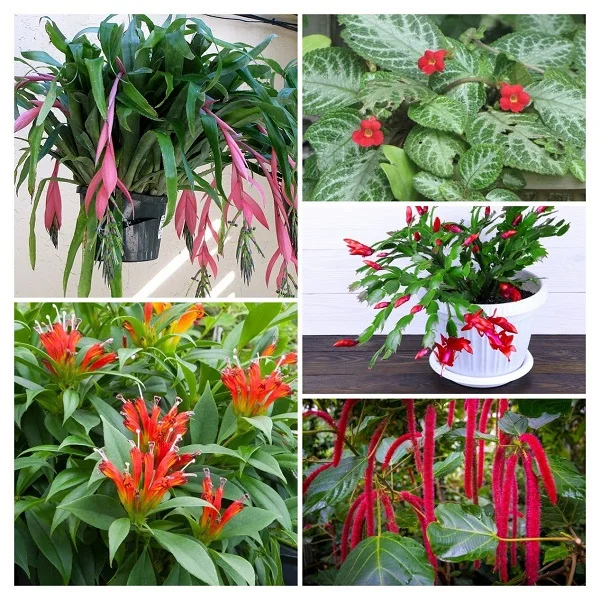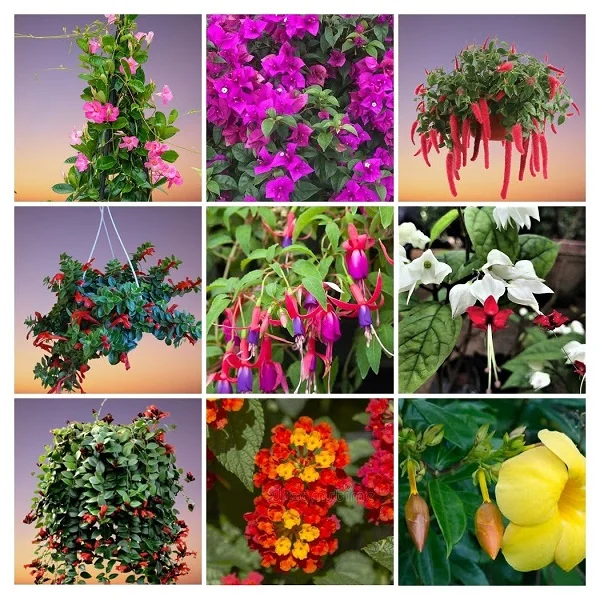Ruellia makoyana (Trailing Velvet Plant) Indoor Care, Propagation, Problems and Remedies
Some links in this post may be affiliate links
Ruellia makoyana (Trailing Velvet Plant) grows best in bright indirect light, warm and humid conditions and consistently moist, rich, well-drained soil coupled with monthly feeding in the growing season.
Trailing Velvet Plant is relatively easy to care for with the right conditions. This guide will cover light, watering, soil requirements, propagation methods, and solutions to common problems to keep your Ruellia makoyana healthy and thriving.
Trailing Velvet Plant also called Monkey Plant is one of the best flowering plants and bears long, flared, trumpet-shaped flowers and velvety, oval-shaped leaves tinged with purple and veined in silver.
The flowers are about 2 inches long while the stems are about 2 feet long and droop gracefully making Monkey Plant ideal for a hanging basket.
Ruellia makoyana is an evergreen perennial plant whose decorative, hairy, silver-veined, dark-green leaves qualifies it for a permanent spot in any space.
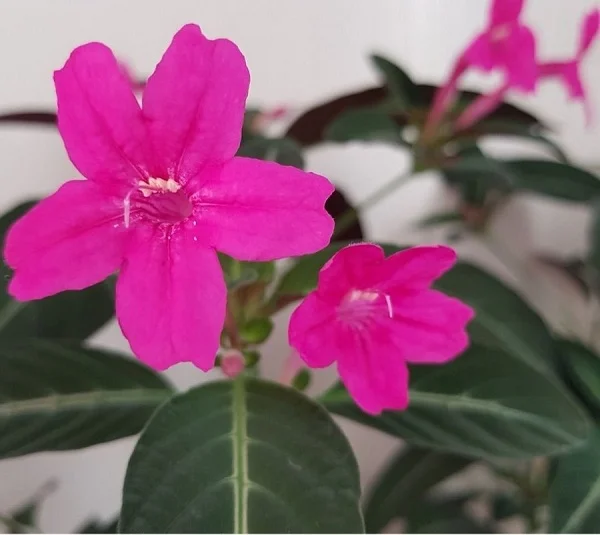
Botanical name: Ruellia makoyana
Family: Acanthaceae
Common names: Trailing Velvet Plant, Monkey Plant
Origin
Ruellia makoyana is native to the rain forests of Brazil where the growing conditions are warm, moist and humid.
Is Ruellia makoyana toxic to pets?
Trailing Velvet Plant is non-toxic to both humans and pets. Ruellia makoyana is safe for cats, dogs and other pets.
Invasiveness
Ruellia makoyana can be invasive if not properly controlled. Take care to destroy any plant remains and avoid growing it in the ground.
Ruellia makoyana Care Indoors
How do you care for Ruellia makoyana indoors.
Care for Ruellia makoyana pertains to giving it bright indirect light (dappled light), average warmth of 18-240C, humidity of 60-70% and consistently moist, fertile, well-drained soil coupled with monthly feeding during the growing season.
Trailing Velvet Plant care requires regular pruning to keep it neat, to encourage a bushy growth and to rejuvenate growth. Repotting is only necessary when it becomes pot-bound. Keep reading for more on the best growing conditions for this plant and how to achieve them.
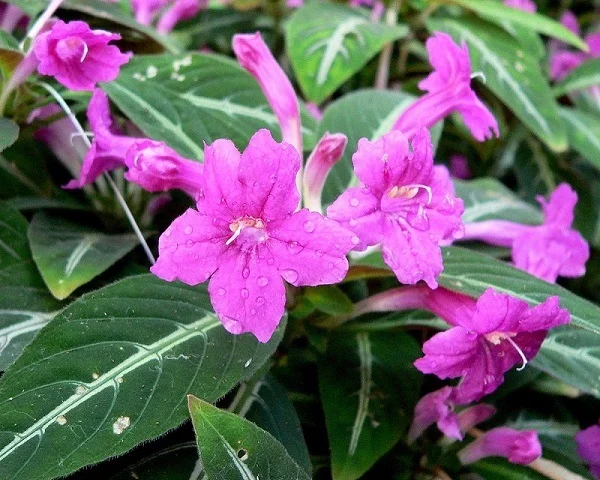
Watering
How often should I water my Trailing Velvet Plant?
Water your Trailing Velvet Plant thoroughly during the growing season when the top 1-2 inches of soil dry out to keep the soil consistently moist. Avoid overwatering as it can result in yellow leaves and mushy stems.
Lessen watering in the cold season to maintain the soil slightly moist. Do not allow the soil to dry out completely as it can lead to wilting and drooping leaves, flowerbud drop, and leaf drop.
Ensure that the pot has a drainage hole to avoid getting soggy soil which can cause root-rot and death of the plant.
Light Requirements
Trailing Velvet Plant thrives in bright indirect light (filtered light). Do not expose the plant to direct sunlight as it can result in sunscorched leaves (brown, dry leaf spots).
Too little light will lead to slow, leggy growth and fewer blooms. Position the plant infront of a bright window or use a grow light if the natural lighting is too low.
Pro tip: Regularly turn the pot to ensure that the plant receives light on all sides for even growth and to prevent unbalanced growth.
Temperature and Humidity
Trailing Velvet Plant blossoms in average warmth of 18-240C. Keep it away from cold drafts as it is not cold-hardy. Protect it from temperatures below 100C to prevent leaf curl, leaf drop, and flowerbud drop.
Ruellia makoyana flourishes in a humidity of 60-70%. Low humidity will lead to poor flowering and brown leaf tips and edges. To elevate humidity, group the plants together, set the pot on a wet pebble tray or use a humidifier. Do not mist the plant to prevent fungal diseases.
Pro tip: Maintain good air circulation for your plant to minimize fungal diseases.
Feeding
Feed your Ruellia makoyana monthly with a phosphorous-rich, water-soluble fertilizer during the growing season (spring and summer) to enhance flowering.
Do not feed in the cold season (fall and winter) as growth is minimal at this time and may result in fertilizer burn and death of the plant.
Potting Mix
The best potting mix for Ruellia makoyana should be a well-draining, nutrient-rich soil. A mix of 50% potting soil, 30% peat moss or coco coir and 20% perlite or sand is ideal for this plant.
Repotting
Repot your Trailing Velvet Plant at the beginning of the growing season in a pot one size larger than the current one only when the plant becomes pot-bound.
Make sure that the pot has a drainage hole and the soil is free-draining soil to avoid soggy soil. Soggy soil can lead to root-rot disease and eventual death of the plant. Check out these self watering pots available on Amazon.
Pruning & Grooming
Pruning Ruellia makoyana entails:
- Removal of dead blooms and leaves to maintain the plant neat and reduce pest and disease infestations.
- Pinching off the growing tips to encourage a bushy growth and to keep the plant compact.
- Trim leggy stems to rejuvenate growth and keep the plant healthy and flourishing.
Occasionally clean the leaves by damp-wiping with a soft cloth to get rid of dust and also discourage pest and disease infestations.
Propagation
Ruellia makoyana propagation can be done at the beginning of the growing season (spring) from stem cuttings or by plant division. Propagation from stem cuttings is the easiest method.
Pro tip: Propagating in spring gives the best success rate, as the plant is actively growing.
1. Ruellia makoyana propagation from stem cuttings
- Take stem cuttings of about 4-6 inches from a healthy plant. Ensure that each cutting has 2-3 leaf nodes.
- Strip off the lower leaves and dip the lower cut end of the cutting in a rooting hormone to hasten rooting.
- Select a 6 or 8 inches pot and ensure that the pot has a drainage hole to prevent the soil from getting soggy to avoid rotting.
- Fill the pot with well-drained, potting mix and moisten the soil slightly.
- Make a hole in the center of the pot and ensure it is wider that the base of the cutting.
- Insert about 2 inches of the lower cut end of the cutting in the hole made above.
- Cover the set up with clear polythene to create a greenhouse effect to promote rooting.
- Place the set up in a warm, brightly lit spot away from direct sunlight.
- Maintain the soil slightly moist until you observe new growth which indicates rooting. Rooting should occur in about 4-6 weeks.
- Allow the plant to be well established before transplanting into a pot one size larger after which you can begin routine care.
Pro tip: For a fuller plant, transfer several cuttings into one pot.
2. Ruellia makoyana propagation by plant division
- Water the plant thoroughly one day before to make it easier to divide and also hasten establishment.
- Carefully, slip the plant out of its pot, remove excess soil, disentangle the roots and cut away any dead roots.
- With a clean, sharp pair of pruning scissors or knife, carefully divide the plant into several sections.
- Select a 6 or 8 inches pot with a drainage hole to prevent rotting.
- Fill the pot with well-draining medium and moisten the soil slightly.
- Make a hole in the center of the pot. Ensure that the hole is slightly wider than the root base of the section.
- Place the section in the previously made hole and lightly firm the soil around the base; maintain the section at the same soil level it was in the previous pot.
- Wet the soil thoroughly until the water drips through the drainage hole.
- Cover the pots with the clear polythene sheet or bag to create a greenhouse effect to hasten establishment.
- Position the pots in a warm, well-lit place away from direct sunlight.
- Keep the soil moist until the new plants are well established.
- Once well established, over a period of two weeks, gradually remove the polythene to acclimate the new plants to ordinary growing conditions.
- Repot the new plants into a pot 1 size larger than the current one in well-drained soil.
- Place the new plants in a warm spot in bright indirect light and begin routine care.
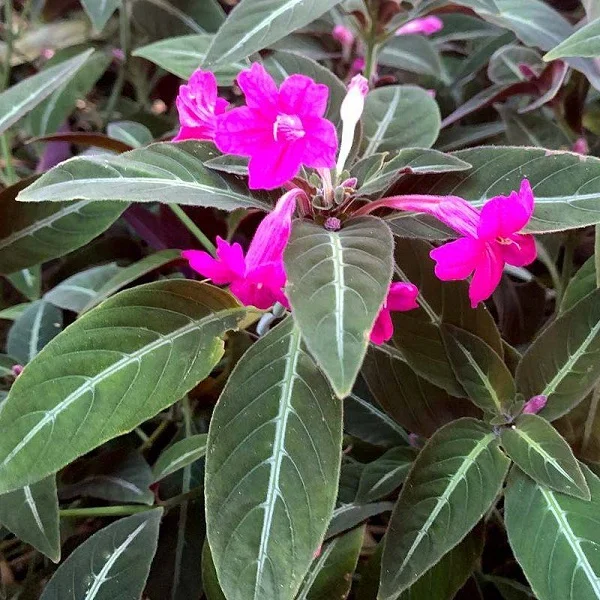
Ruellia makoyana Common Problems & Solutions
Ruellia makoyana (Trailing Velvet Plant) problems are lack of blooms, flowerbud drop, wilting and drooping leaves, brown leaf tips and edges, curled leaves, leaf spots, pests and diseases among others. Keep reading for more on these problems, their remedies and solutions.
Lack of blooms
Ruellia makoyana is not blooming due to little light, underwatering, and Nitrogen-rich fertilizer.
How to fix it
Little light: Position the plant in a brighter spot or instal a grow light if you do not have adequate light in your home.
Underwatering: Water when the top 1-2 inches of soil dry out. Do not leave the soil to dry out compeletely.
Nitrogen-rich fertilizer: Do not feed with Nitrogen-rich fertilizer as it promotes foliage growth at the expense of blooms. Instead feed monthly with a phosphorous-rich, water-soluble fertilizer in the growing season.
Flowerbud drop
Flowerbud drop in Trailing Velvet Plant is due to inconsistent watering, low humidity and temperature stress.
How to fix it
Inconsistent watering: Keep the soil consistently moist and slightly moist in the cold season but never allow the soil to dry out completely.
Low humidity: To maintain a high humidity, use a humidifier, set the pot on a wet pebble or group the plants together to great a humid microclimate.
Temperature stress: Place the plant way from drafts from AC units, windy doors and windows, heating sources among others to avoid sudden changes in temperature.
Wilting and drooping leaves
Wilting and drooping leaves on Ruellia makoyana are caused by underwatering, extreme temperatures, direct sunlight, and dry air.
How to fix it
Underwatering: Maintain the soil consistently moist but slightly moist in the cold season. Do not allow the soil to dry out completely.
Extreme temperatures: Keep the plant away from both hot and cold drafts to avoid temperature stress.
Direct sunlight: Position the plant under filtered (dappled) light.
Dry air: Set the pot on a wet pebble tray or use a humidifier to raise humidity.
Brown leaf tips and edges
Brown leaf tips and edges on Ruellia makoyana are due to low humidity and salt buildup.
How to fix it
Low humidity: Group the plants together, set the pot on a wet pebble tray or use a cool mist humidifier to upscale humidity.
Salts buildup: Flush out accumulated salts from the soil every 2-3 months by running a stream of water through the soil until it drains through the drainage hole.
Leaf curl and leaf drop
Leaf curl and leaf drop in Ruellia makoyana is due to too cold temperatures. Keep it away from cold drafts to maintain warm temperatures of 18-240C.
Brown, soft leaf spots
Brown, soft leaf spots in Trailing Velvet Plant are due to overwatering or soggy soil. Do not water on a schedule; water only when the top 1-2 inches of soil dry out. In addition, ensure that the pot has a drainage hole and the soil is well-draining.
Brown dry leaf spots
Brown, dry leaf spots in Ruellia makoyana are sunscorch marks due to exposure to direct sunlight. Shield the plant or keep it away from direct sunlight.
Pests
Trailing Velvet Plant is prone to spider mites, scale insects and aphids infestations. Isolate the affected plant to prevent spread to the other plants and treat it insecticidal soap or neem oil. Make sure to follow the directions on the label.
Conclusion
Ruellia makoyana (Trailing Velvet Plant) is a stunning, easy-care plant that brings a touch of tropical beauty indoors. With proper lighting, watering, humidity, and occasional pruning, it will thrive and reward you with lush foliage and delicate blooms. By following these care tips and troubleshooting solutions, you can enjoy a vibrant and healthy plant in your home for many years.
You liked it? Share on social media.
Related Content
Amazon Associates Disclosure
Homeplantsguide.com is a participant in the Amazon Services LLC Associates Program, an affiliate advertising program designed to provide a means for sites to earn advertising fees by advertising and linking to amazon.com.



